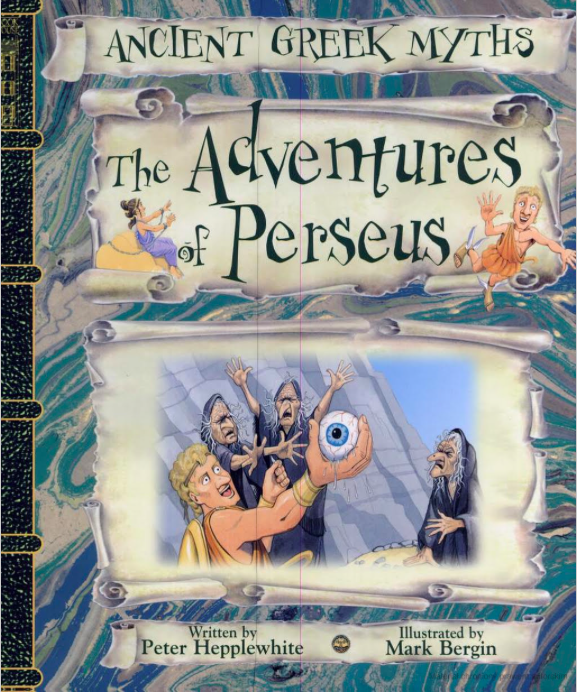Title of the work
Country of the First Edition
Country/countries of popularity
Original Language
First Edition Date
First Edition Details
Peter Hepplewhite, The Adventures of Perseus, ill. Mark Bergin (Ancient Greek Myths). Brighton: Salariya Book Company Book House, 2004, 32 pp.
ISBN
Genre
Illustrated works
Myths
Target Audience
Children
Cover

Courtesy of The Salariya Book Company.
Author of the Entry:
Viktoryia Bartsevich, University of Warsaw, v.bartsevich@student.uw.edu.pl
Peer-reviewer of the Entry:
Elżbieta Olechowska, University of Warsaw, elzbieta.olechowska@gmail.com
Lisa Maurice, Bar-Ilan University, mauril8@gmail.com

Mark Bergin
, b. 1961
(Illustrator)
Mark Bergin was born in Hastings, England. He studied at Eastbourne College of Art. He works as an illustrator of children’s books: The Voyages of Odysseus written by Sue Reid, Gods and Goddesses in the Daily Life of the Vikings written by Jen Green, Going to War in Ancient Greece written by Adrian Gilbert, Going to the War in Ancient Egypt written by Anne Millard, An Ancient Greek Temple: The Story of the Building of the Temple in Ancient Greece written by J. Malam and others.
Sources:
The cover of the book The Adventures of Perseus.
Profile at the biography.jrank.org (accessed: July 4, 2018).
Bio prepared by Viktoryia Bartsevich, University of Warsaw, v.bartsevich@student.uw.edu.pl

Peter Hepplewhite
, b. 1954
(Author)
Peter Hepplewhite was born in Hartlepool, England. He is a British author and former history teacher who works as an education officer at Tyne and Wear Archive Services. He wrote two books in the series A World in Flames, about World War II. Peter Hepplewhite is best known for The Awesome Egyptians in the series Horrible Histories. He has written many historical books for children: The Fact or Fiction Behind the Victorians (Truth or Busted), The Fact or Fiction Behind the Romans (Truth or Busted), Hometown History Newcastle, The History Detective Investigates: Tudor Exploration and others.
Bio prepared by Elżbieta Olechowska, University of Warsaw, elzbieta.olechowska@gmail.com

David Salariya
, b. 1954
(Illustrator)
David Salariya was born in 1954 in Dundee, Scotland. He is the founder of Salariya Book Company. David Salariya is an illustrator. His first illustration was done for Reader’s Digest.
Source:
Interview at the creativeinterviews.com (accessed: April 17, 2018).
Interview at the childrensillustrators.com (accessed: April 17, 2018).
Bio prepared by Elżbieta Olechowska, University of Warsaw, elzbieta.olechowska@gmail.com and Viktoryia Bartsevich, University of Warsaw, v.bartsevich@student.uw.edu.pl
Translation
Polish: Mity starożytnej Grecji: Przygody Perseusza, trans. Janusz Ochab, Warszawa: Firma Księgarska Jacek i Krzysztof Olesiejuk Inwestycje, 2006.
Spanish: Mitos Griegos: Las aventuras de Perseo, Bogotá: Panamerica Editorial, 2007.
Summary
The story begins at the birth of Perseus, from the prophecy of the death of King Acrisius of Argos by the hand of his daughter Danae’s son. Zeus falls on Danae in the form of a golden shower, and their son Perseus is born. Acrisius puts his daughter and grandson into a wooden chest and throws them into the sea. The unfortunate pair are rescued by Zeus, Poseidon, and the fisherman Dictys. The King of Seriphos, Polydectes, brother of Dictys, falls in love with Perseus's mother. He asks Perseus to bring him Medusa's head as a wedding gift; Athena and Hermes help him complete this task. Perseus sets out to see the three Graeae Sisters who knew the way to Medusa. Arriving at the place, the hero, armed with an adamantine sword, a polished shield, winged sandals, and the cap of invisibility, kills the monster. Coming back home, Perseus escapes pursuit by the Gorgons and visits Atlas, King of Mauretania, who refuses him hospitality; Perseus turns him to stone. He saves his future wife, Andromeda, from Cepheus, the sea monster sent by Poseidon. Then, using Medusa's magical head, he rescues his mother, who had to seek refuge in a temple from King Polydectes – who meets the same fate as Atlas. The myth ends with the same story with which it began, the prophecy – King Acrisius is accidentally killed during games in Larissa by Perseus throwing a discus.
There are additional themes in the story, including the role of Zeus, the three Graeae Sisters, Medusa, what happened to Medusa's head, why Andromeda's parents were willing to sacrifice their daughter's life, and more.
Analysis
Like every book in the series "Ancient Greek Myths", The Adventures of Perseus is very well composed. The text is written in an accessible way; the illustrations are colorful and complement the text. The myth that the creators convey does not bring any new elements; it has the usual, all-known form and content. The negative aspects of the myth are shown in the illustrations without causing fear; the monsters are not presented as monsters but as different creatures. The publication ends with a hand-held glossary that explains to the young reader who was who in a given myth. The book also contains an index, which gives the number of pages on which there is information about the interesting characters. It is a typical retelling of myth for children, increasing their awareness of Greek mythology and serving as a didactic aid.


